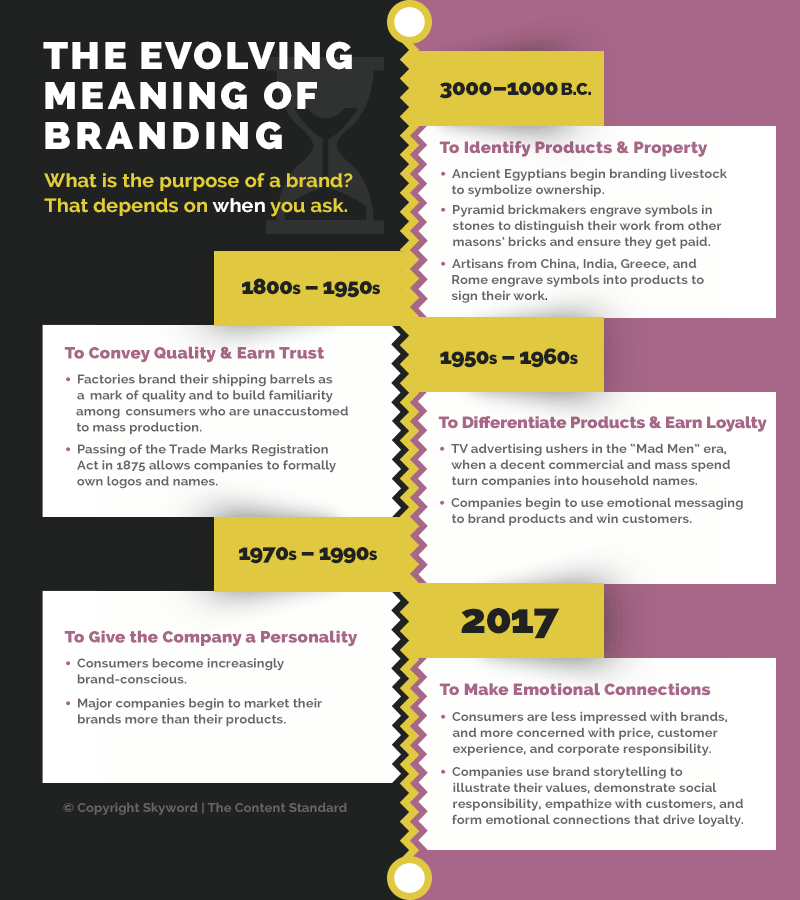Creative Thinking
What Is Branding? A Brief History
By Taylor Holland on August 11, 2017
As marketers, we talk a lot about branding-branding websites, branding content, branding research studies, branding events. The list goes on and on. But what is branding? Not what do we mean by branding, but what does the word actually mean?
If you don't already know the answer, it will seem pretty obvious. The term derives from the Old Norse word brandr or "to burn," and refers to the practice of branding livestock, which dates back more than 4,000 years to the Indus Valley. Of course, branding has evolved over the centuries-from farmers claiming their property, to artisans claiming credit for their work, to factories claiming their products, to companies claiming their products were better than others.
What we brand, how we brand it, and why we brand it has changed. But branding in the twenty-first century is still about taking ownership, and not just for property and products. It's about owning what your company values and represents, owning up to your shortcomings, and earning customer trust and loyalty through your words, your actions, and your stories.
These days, consumers have more information and more choices than ever. Unless companies can offer far superior products or far lower prices than the competition, it's hard to stand out in the crowded marketplace. Success is no longer determined by who has the biggest advertising budget or the most recognizable logo. It's determined by who makes the greatest emotional connections.
As marketing leaders continue to wrap their heads around how branding works in the digital age, many brands are in trouble. But it's not the first time. More than once, experts have declared branding dead. Still, like superheroes and soap opera villains, it never stays dead for long. If anything, branding might be more important today than ever.
What can modern marketers learn from the history of branding?
The Origins of Branding
The word brand dates back to Old Norse, the ancient North Germanic language from which modern Scandinavian languages derived. Brand originally referred to a piece of burning wood. It wasn't used as a verb until late Middle English, when it came to mean "mark permanently with a hot iron." By the seventeenth century, it referred to a mark of ownership made by branding.
The practice of branding livestock is much older than the word. Cave paintings from the Stone Age suggest that early man might have marked cattle with symbols drawn in paint and tar. By 2000 BC, livestock owners switched to a more permanent method: burning. Egyptian funeral monuments, approximately 4,000 years old, depict branded cattle.
During this time, brands were also used to identify goods. Pottery makers from China, India, Greece, Rome, and Mesopotamia (now Iraq) used different engravings to identify not only who made ceramic goods but also what types of materials were used and where the goods were produced. Some of the earliest known marked Chinese pottery dates back 4,000 to 5,000 years. Archaeologists have also identified roughly 1,000 unique potters' marks in use during the first three centuries of the Roman Empire.
Potters weren't the only artisans to brand their work. In Ancient Egypt, masons engraved symbols-called stonecutters' signs-on the bricks they produced for the pyramids and other Pharaoh-led construction projects. This helped distinguish their work from that of other masons and ensured they were fairly paid. Bricks often included quarry marks, which indicated where the stones came from. The oldest materials with these symbols are around 6,000 years old. Similar markings were used by masons in Greece, Israel, Turkey, Syria, and later in Medieval Germany.
Image attribution: Les Anderson
Watermarks also emerged in the Medieval period as a way for paper makers, printing houses, and other guilds to distinguish their products and property. Later, during the Renaissance period, artists like Michelangelo introduced a new type of personal branding: They began actually signing their names to their work, rather than using symbols.
A couple of centuries later, during the Industrial Revolution, another type of branding was born-mass branding-this time to solve a new business challenge. Consumers were accustomed to buying local products from local merchants. Generic products created en masse didn't have the same appeal. So factories borrowed a tactic from winemakers and began branding logos onto the barrels used to transport their goods. Soon, they also began marking individual products, giving birth to such popular American brands as Campbell's Soup, Coca-Cola, Juicy Fruit, and Aunt Jemima.
By the late nineteenth century, companies had invested so much in branding that they needed a way to protect those investments from competitors. In 1875, they got it with the passing of the Trade Marks Registration Act.
Now branding wasn't just something companies did; it was something they could own. And that changed everything.
The Birth (and Death?) of Corporate Brands
Advertising was still a relatively new and underutilized medium, but a man named James Walter Thompson wanted to change that. His advertising firm was the first to establish a creative department to design content for clients. In 1889, his firm placed an in-house ad claiming that 80 percent of advertising in the US was placed by J. Walter Thompson New York.
But Thompson didn't keep his secrets to himself. In 1901, he published The Thompson Blue and Red Books of Advertising-comprehensives guide to advertising opportunities in all markets. Here, he explained the concept of trademark advertising, an early definition of what we now call branding.

Thompson's advice couldn't have come at a better time. With so many new brands entering the market, it was becoming harder and harder for companies to differentiate their products from those of competitors, especially as quality became more standardized from one brand to the next.
Companies soon began introducing slogans, mascots, and radio jingles to promote their brands, not just their products. In 1941, Bulova clocks released the first TV commercial, which reached 4,000 TV sets. By 1952, TV ad revenue surpassed magazine and radio ad sales, ushering in the Golden Age of Advertising (a.k.a. the "Mad Men" era).
TV advertising didn't just give companies a better way to reach consumers. The new medium also allowed for new branding strategies. Thanks to the longer, live-action format of these ads, brands could do more than ask consumers to buy their products. They could make an emotional appeal.
In the 1950s, several leading consumer packaged goods companies-including Procter & Gamble, General Foods, and Unilever-developed the concept of brand management, or what we now call marketing. Suddenly, branding wasn't just about putting a logo on a product. It was about giving the company a strategic personality and putting a human face on the brand. Where early ads might have just shown the product or someone using the product, new ads began to tell stories.
For example, in this 1950s Procter & Gamble ad, a little girl borrows laundry detergent from a friendly neighbor:
And this Tang commercial took viewers all the way to space:
Over the next few decades, consumers who had never given much thought to what type of laundry detergent they bought suddenly became very brand-conscious. And, of course, they were most conscious of the brands that spent the most money on advertising. In this era, the formula for winning was clear: Mass spend plus a good commercial equaled eyeballs and dollar signs.
Then, in 1984, Apple changed the branding game once again. Its super successful Super Bowl commercial (directed by world-famous filmmaker Ridley Scott) reached 46.4 percent of American households. But it wasn't the reach that made this ad special; it was the brand strategy. The groundbreaking (if somewhat creepy) storytelling ad encouraged viewers to break free from conformity. It also introduced the first Macintosh computer, but not until the last few seconds of the spot. Instead, the ad was all about the brand and what it wanted to make customers feel.
Despite the rousing success of Apple's commercial, and the many other great ads that were inspired by this marketing strategy, popular brands were again struggling to compete with lower-priced competitors. This strain came to a head on April 2, 1993, when tobacco company Philip Morris announced it would cut the price on its Marlboro cigarettes by 20 percent to compete with generic brands. Philip Morris stock plummeted, taking the entire stock market down with it.
Confidence in branding was at all-time low, and many experts even declared Marlboro Friday the "death of brands." Except it wasn't.
The Death of Brands (Yeah, We've Heard That Before)
There's a lot of truth to the saying "history repeats itself," but not always in branding. The meaning of the word has evolved so much over the centuries that even people who do it for a living have never made the connection between modern marketing and livestock. (It wasn't just a lightbulb moment for me. I asked a few colleagues, and they didn't know off-hand either.)
But two things have always been true in the history of branding: It's not easy, and you can't count on what worked yesterday to work tomorrow.
Today, competition is stiffer than ever and quality standards are closer than ever. Few brands can really argue that their products are better than everything else on the market. Just look at the packaged foods industry. Today, private labels (meaning generic or store brands) account for 14 percent of grocery sales, and experts expect that number to keep rising.
The popularity of generic brands in the US has even attracted European private label grocers, Aldi and Lidl, to the States. Aldi, which currently has about 1,600 locations nationwide, plans to add 900 more stores over the next five years. And Lidl will open its first US location in Newport News later this month.
At the same time, new private label digital grocers are emerging, including the aptly named company Brandless. The digital retailer's entire line of simply packaged healthy foods and organic cleaning supplies sells for $3 or less. The site just launched last month, but it's sure to grow quickly. In fact, the company has already raised $50 million in funding from investors such as New Enterprise Associates, Google Ventures, Redpoint Ventures, Cowboy Ventures, and Slow Ventures.
If being brandless is now a brand in itself, what does that mean for marketers? Are brands finally dying for real this time? I certainly wouldn't bet on it.
If anything, branding is more important than ever in the digital age. It's just different. It's at once all about the brand and not about the brand at all.

Old-school advertising doesn't work on most digital channels. People don't want to read about your products on social media, but they'll certainly read (and share) great stories from brands they trust. They don't want to read blogs or listen to podcasts about how great your company is, but they will read blogs and listen to podcasts that provide useful information or tell interesting tales. Just look at GE's sci-fi podcast The Message, which garnered 1.2 million downloads in the first eight weeks after its release.
There's another benefit to branding in the digital age. Consumers might be more price-conscious than brand-conscious these days. But they're also more socially conscious. More than ever, they want to do business with companies that value what they value and support causes that matter to them. And study after study has shown that consumers-especially millennials-are willing to pay more for those brands.
That doesn't sound like the end of brands to me. It seems more like a new beginning.
For more fresh perspectives on today's marketing trends, subscribe to our monthly newsletter, Content & Context.


